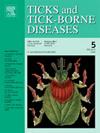以啮齿动物病原体库为目标的局部杀螨剂处理策略对降低加利福尼亚州寻找宿主的太平洋伊蚊若虫密度的效果
IF 3.4
2区 医学
Q2 INFECTIOUS DISEASES
引用次数: 0
摘要
莱姆病主要由严格感伯氏疏螺旋体引起,是美国最流行的媒介传播疾病。莱姆病螺旋体通过脊椎动物宿主和蜱虫媒介之间的病原体传播的地方性动物循环得以维持。在美国东部的自然环境中,已经研究了水库宿主靶向策略是否能够破坏布氏疏足杆菌的地方性传播周期。然而,在美国西部,没有研究检查氯菊酯和溴氰菊酯为基础的局部杀螨剂对太平洋伊蚊连续多年治疗的效果。我们评估了2023年至2024年在加州针对鼠类储存库的局部杀螨剂处理,并研究了它们对侵染啮齿动物宿主的太平洋夜蛾幼虫和寻找宿主的太平洋夜蛾若虫密度的影响。改良饵料站外用杀螨剂,在3 - 5月太平洋夜蛾幼虫和若虫寻找寄主活动高峰期间,对黑足木鼠、灰松鼠和几种大孢子虫进行局部杀螨处理。在3个重复小区局部施用氯菊酯和溴氰菊酯杀螨剂。结果表明:2024年,杀螨处理区太平洋纹夜蛾幼虫负荷较对照区下降96%;此外,2024年杀螨处理区寻找寄主的太平洋姬鼠密度较对照区降低56%。这表明,在美国西部,以宿主为目标的局部杀螨治疗是一种非常有效的策略,可以减少啮齿动物宿主附着的蜱虫以及寻找宿主的太平洋I.。本文章由计算机程序翻译,如有差异,请以英文原文为准。

Efficacy of rodent pathogen reservoir-targeted topical acaricide treatment strategies to lower the density of host-seeking Ixodes pacificus nymphs in California
Lyme disease, caused primarily by the bacterium Borrelia burgdorferi sensu stricto (s.s.), is the most prevalent vector-borne disease in the United States. Lyme disease spirochetes are maintained through enzootic cycles of pathogen transmission between vertebrate reservoir hosts and tick vectors. Reservoir host targeted strategies have been examined for their ability to disrupt enzootic transmission cycles of B. burgdoferi s.s. within natural environments in the eastern U.S. However, there are no studies in the western U.S. examining the effect of permethrin- and deltamethrin-based topical acaricides on Ixodes pacificus over consecutive years of treatment. We evaluated rodent reservoir-targeted topical acaricide treatments from 2023 to 2024 in California and examined their impact on larval I. pacificus infesting rodent host species and the density of host-seeking nymphal I. pacificus. Modified bait stations contained topical acaricides to treat dusky-footed woodrats (Neotoma fuscipes), western gray squirrels (Sciurus griseus), and several Peromyscus species throughout the peak of larval and nymphal I. pacificus host-seeking activity between March and May. Topical acaricide treatments including permethrin and deltamethrin were applied on three replicate plots. Our results show that larval I. pacificus burdens decreased by 96 % at acaricide treated plots compared to control plots in 2024. In addition, the density of host-seeking nymphal I. pacificus was 56 % lower at acaricide treated plots compared to control plots in 2024. This suggests that in the western U.S., host-targeted topical acaricide treatments are a highly effective strategy for reducing rodent reservoir-attached ticks as well as the abundance of host-seeking nymphal I. pacificus.
求助全文
通过发布文献求助,成功后即可免费获取论文全文。
去求助
来源期刊

Ticks and Tick-borne Diseases
INFECTIOUS DISEASES-MICROBIOLOGY
CiteScore
6.90
自引率
12.50%
发文量
185
审稿时长
6-12 weeks
期刊介绍:
Ticks and Tick-borne Diseases is an international, peer-reviewed scientific journal. It publishes original research papers, short communications, state-of-the-art mini-reviews, letters to the editor, clinical-case studies, announcements of pertinent international meetings, and editorials.
The journal covers a broad spectrum and brings together various disciplines, for example, zoology, microbiology, molecular biology, genetics, mathematical modelling, veterinary and human medicine. Multidisciplinary approaches and the use of conventional and novel methods/methodologies (in the field and in the laboratory) are crucial for deeper understanding of the natural processes and human behaviour/activities that result in human or animal diseases and in economic effects of ticks and tick-borne pathogens. Such understanding is essential for management of tick populations and tick-borne diseases in an effective and environmentally acceptable manner.
 求助内容:
求助内容: 应助结果提醒方式:
应助结果提醒方式:


